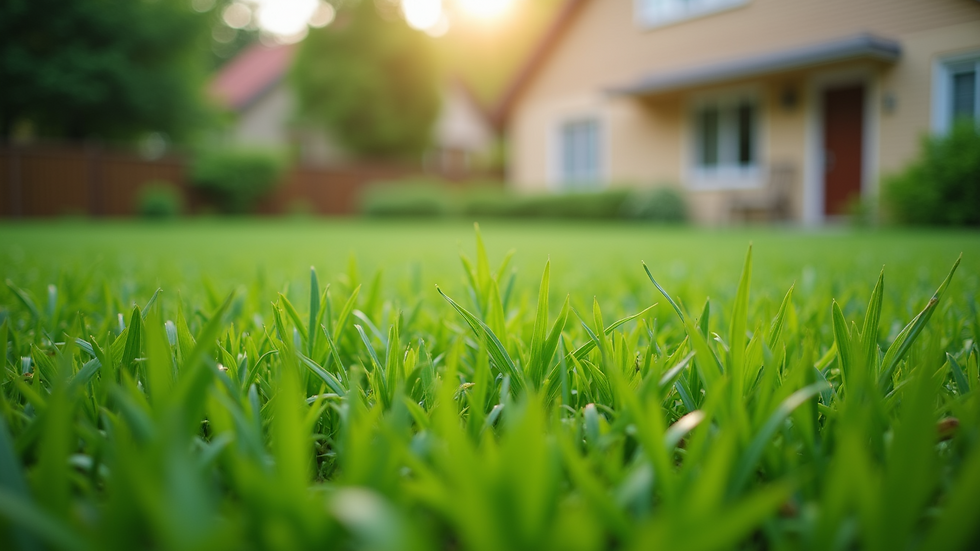Effective Broadleaf Weed Control for Healthier Lawns
- Deano Holliday
- Aug 19
- 4 min read
Maintaining a lush, green lawn free of weeds is a goal for many homeowners and gardeners. Weeds, especially broadleaf varieties, can quickly take over your lawn, competing with grass for nutrients, water, and sunlight. Effective weed management is essential to keep your lawn healthy and vibrant. This article provides practical weed management tips and explores various methods to control broadleaf weeds, ensuring your lawn stays in top condition.
Understanding Broadleaf Weeds and Their Impact
Broadleaf weeds are a common problem in lawns. They have wide, flat leaves and often grow faster than grass, making them highly competitive. Examples include dandelions, clover, chickweed, and plantain. These weeds can spread rapidly, creating unsightly patches and weakening your lawn’s overall health.
Broadleaf weeds thrive in disturbed soil and areas where the grass is thin or stressed. They can also indicate underlying lawn problems such as poor soil quality, improper mowing, or inadequate watering. Identifying these weeds early is crucial for effective control.
Why Broadleaf Weeds Are Difficult to Control
They produce many seeds that spread easily by wind or animals.
Some have deep taproots that make removal challenging.
They can tolerate a range of environmental conditions.
They often grow back quickly after being cut or pulled.
Understanding these characteristics helps in choosing the right control methods to prevent their spread and protect your lawn.

Practical Weed Management Tips for a Healthy Lawn
Effective weed management starts with prevention and maintaining a healthy lawn. Here are some practical tips to reduce weed growth and improve your lawn’s resilience:
Mow Regularly and Correctly
Keep your grass at the recommended height for your grass type. Mowing too short weakens grass and encourages weed growth. Aim to remove no more than one-third of the grass blade length at a time.
Water Deeply and Infrequently
Watering deeply encourages deep root growth in grass, making it more competitive against weeds. Avoid frequent shallow watering, which benefits weed seeds.
Fertilize Appropriately
Use a balanced fertilizer to provide essential nutrients. Healthy grass can outcompete weeds more effectively.
Aerate Your Lawn
Aeration improves soil drainage and root growth, reducing compacted areas where weeds thrive.
Overseed Bare Patches
Fill in thin or bare spots with grass seed to prevent weeds from establishing.
Remove Weeds Early
Hand-pull or dig out weeds before they flower and produce seeds.
By following these weed management tips, you create an environment where grass thrives and weeds struggle to establish.

Will Pouring Straight Vinegar on Weeds Kill Them?
Many gardeners wonder if pouring straight vinegar on weeds is an effective control method. Vinegar contains acetic acid, which can burn the leaves of plants on contact. However, there are important considerations:
Effectiveness: Vinegar can kill the above-ground parts of weeds but usually does not kill the roots, especially for deep-rooted broadleaf weeds. This means weeds may regrow after treatment.
Concentration: Household vinegar typically contains 5% acetic acid, which may not be strong enough for tough weeds. Horticultural vinegar with higher concentrations (20% or more) is more effective but must be used with caution.
Non-selective: Vinegar will damage any plant it touches, including grass, so careful application is necessary.
Environmental Impact: Vinegar breaks down quickly and is less harmful than synthetic herbicides, making it a popular choice for organic gardening.
How to Use Vinegar Safely and Effectively
Apply on a dry, sunny day for best results.
Use a spray bottle or brush to target weeds directly.
Avoid spraying on windy days to prevent drift onto desirable plants.
Repeat applications may be necessary for persistent weeds.
While vinegar can be part of your weed control strategy, it is often best combined with other methods for long-term success.

Chemical and Organic Options for Broadleaf Weed Control
When natural methods are insufficient, chemical or organic herbicides can help manage broadleaf weeds effectively. Choosing the right product depends on your lawn type, weed species, and environmental considerations.
Chemical Herbicides
Selective Herbicides: These target broadleaf weeds without harming grass. They are ideal for lawns and include ingredients like 2,4-D, dicamba, and MCPP.
Pre-emergent Herbicides: Applied before weed seeds germinate, these prevent weed growth but do not kill existing weeds.
Post-emergent Herbicides: Used to kill actively growing weeds.
Always follow label instructions carefully to avoid damage to your lawn and the environment.
Organic Herbicides
Made from natural ingredients such as clove oil, citric acid, or fatty acids.
Less persistent in the environment but may require multiple applications.
Suitable for organic gardening and sensitive areas.
Integrated Weed Management
Combining cultural practices, mechanical removal, and herbicide use provides the best results. For example:
Start with proper lawn care and manual weed removal.
Use selective herbicides for stubborn broadleaf weeds.
Apply pre-emergent herbicides in early spring to prevent new weeds.
For those seeking professional-grade solutions, broadleaf weed control products and services can offer targeted and effective treatments.
Maintaining Your Lawn After Weed Control
After successfully managing broadleaf weeds, maintaining your lawn is key to preventing future infestations. Here are some ongoing care tips:
Regular Monitoring: Check your lawn weekly for new weed growth.
Consistent Mowing and Watering: Keep grass healthy and competitive.
Seasonal Fertilizing: Feed your lawn according to seasonal needs.
Soil Testing: Test soil pH and nutrient levels every few years to adjust care practices.
Mulching and Composting: Use organic matter to improve soil health.
By staying proactive, you can enjoy a beautiful, weed-free lawn year-round.
Taking control of broadleaf weeds requires a combination of knowledge, effort, and the right tools. Whether you prefer natural methods or professional treatments, these weed management tips will help you achieve a healthier, more attractive lawn. Remember, early intervention and consistent care are the secrets to long-term success.




Comments